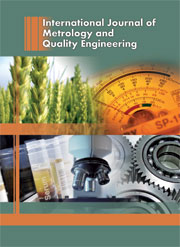Article contents
Characterization of Rockwell hardness indenter Tip using imageprocessing and optical profiler and evaluation of measurement uncertainty
Published online by Cambridge University Press: 02 December 2014
Abstract
Hardness is a measure of the resistance of a material to be penetrated and eroded bysharp projections of other materials such as diamond. The process of creating sharpprojections on any test surface is known as indentation. Hardness measurement of anymaterial is the result of a complex process of deformation during indentation. Theindenter tip geometry, which includes radius of curvature at the tip and tip angle,affects the hardness measurement by influencing the nature of the penetration process onthe test surface, because every indenter deforms the specimen surface with a differentgeometry. The controlled indenter geometry can improve the consistency of hardnessmeasurement. In this paper we report the estimation of two important geometricalparameters, radius of curvature and tip angle of a Rockwell indenter by using a simplemethod of image processing and compare the results with those obtained with a traceable 3Doptical profiler. Evaluation of uncertainty in measuremts is carried out as per ISOguidelines (ISO-GUM) and a detailed uncertainty budget is presented. The tip angleestimted is 119.95 degree. The radius of curvature is estimted to be 199.96 ± 0.80μm by image analysis whichagrees well with the value estimated by using optical profiler i.e. 199.12 μm.
Information
- Type
- Research Article
- Information
- Copyright
- © EDP Sciences 2014
References
- 5
- Cited by

